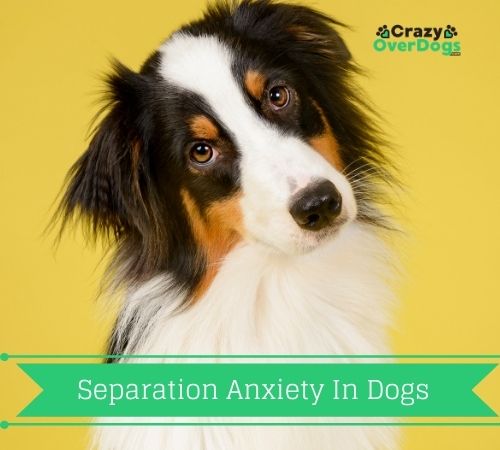Why do dogs get separation anxiety? For most dogs, being left alone just does not come naturally to them. It is therefore not advisable not to leave pets alone for long periods of time because the issue of separation anxiety in dogs can then develop in your pet.
The content takes around 7 minutes to read, but if you are in a hurry, we have also included a table of contents below so you can see at a glance what the content is.
Also, make sure to check out today’s deals to SAVE money on dog products by clicking on the graphic below.
——————————
Over many years, they have evolved alongside us in family groups and love to be in our company. Indeed, like us, they are social animals.
If you recognize the symptoms early on, it can help to treat and stop separation anxiety in dogs at an early stage. Indeed, most rescue organizations will not hand over a dog to a prospective owner, if they are out all day.
However, if they are left alone for short periods when they are young, and as they get older, they will grow up feeling comfortable and relaxed when left alone for a short period.
————————————–
“I think dogs are the most amazing creatures. They give unconditional love. For me, they are the role model for being alive.”
………………Gilda Radner
—————————————
Table Of Contents
Signs and Symptoms of Separation Anxiety:

If you find that your pet is anxious about being left alone, it may display some symptoms or signs listed below.
1) As soon as you leave home, it shows signs of distress and may also become quite upset. Its breathing and heart rate increase. It also might pant, start wandering about, or even need to go to the toilet.
2) He scratches at the door or carpet, jumps up at the windowsill, because he is trying to follow you, looking for a way out to get to you. If that does not work, he will usually start barking or howling in the hope that you will return to him.
3) After about 10 minutes, your pet may settle down and now is looking for something to chew on, which is usually something that carries your scent. Unfortunately, this item might end up in small pieces.
When you return, you may find that your pet may become very excited. They also may be drinking too much due to feeling stressed. In a reverse scenario, when they see that you are preparing to go out, they will follow you around the home and pace or pant.
The ultimate aim as a pet owner is to help your dog to become comfortable and relaxed when they are left alone in the house.
——————————-
Preparing The Area:
A good idea is to decide on a specific area for the dog to be left alone. We use the kitchen area because if accidents happen it’s easy to clean the tiled floor.
We know people who use stair gates because they are not as scary as a closed door. The dog or dogs can see you and smell you which leads to less stress on their part. We also place in our area, a bed, toys, and a bowl or two of water, depending on the number of dogs.
Some people leave a radio on because they find it does help their pet by providing a form of company. In addition, it can muffle noises from outside, which may startle the dog.
—————————–
Training Your Dog:

A great start to the training is to place your dog behind the stair gate, in the area which you have allocated. One of the secrets is to give him a tasty and chewy treat. A great suggestion is a Kong Toy filled with treats.
After a few minutes open the gate and stay within earshot so that your pet knows you are still around. He should be still engrossed with the treat.
If your dog decides to follow you, then return to the allocated room and stay with them. However, it’s important to try to not interact with them. When they become comfortable, they shut the gate for a few minutes.
Over a period of days, gradually increase this time with the gate. During this aspect of the training, it’s important to ensure that your dog feels relaxed enough, to be left alone in the allocated area over a longer period.
To help with this transaction, return to him after a few minutes, and give him a tasty treat. Once he is comfortable tucking into the treat, then leaves the home.
You can increase this period of being left alone to 30 minutes, over a period of time. It’s important to take it slowly as some dogs will progress more slowly than others and therefore you must monitor their behavior.
————————–
Leaving The Home:
You should particularly pay attention to their behavior as you are starting to leave. Are they feeling anxious and displaying signs such as pacing or panting? If this happens, then take a few paces back with the training.
Once they began to look calm and relaxed, they leave the home for short periods of time, increasing the time period, slowly and in small steps, over a period of several days.
Try to get into a routine with the greetings, upon your return. Keep them low-key and friendly. If you want to leave the dog for several hours, make sure that it has had a good walk and gone to the toilet beforehand. It has been found that a small meal can actually make some dogs, feel relaxed and want to go for a short nap.
————————
The Reasons Dogs Are Anxious When Left Alone:
Here are the most common reasons for this kind of behavior.
1) If your dog is of a nervous and sensitive nature, then it’s more probable that they will develop separation anxiety. Dogs are pack animals by nature.
2) The dog is scared of something specific that happens on a daily basis or has happened just once. This can be something such as a postman or courier delivering the mail or a massive thunderstorm.
3) Their pet companion, with whom they have developed a close and loving bond, dies, and they are now on their own.
4) Rescue dogs – They can struggle very much with being re-homed because they have to adapt to a new home and new owners.
————————————–
“When an 85 pound mammal licks your tears away, and then tries to sit on your lap, it’s hard to feel sad.”
……………………Kristan Higgins
————————————–
Always Be Always Patient and Loving:
If you come home and find your home damaged or messed up in some way, it’s very natural to be angry, but try to be calm as punishment will not help. If the dog senses that you are angry with them, it might display a form of behavior called “appeasement behavior”.
The signs are – their tail may go between their legs, they may look away or they may lower their body.
Please remember that your dog looking guilty is only their way of responding to your disappointment or anger.
Owners have to remember that dogs associate any form of punishment with what they are doing in real-time, not something that happen a few hours previously.
Thus punishing the dog can only make the problems much worse. In addition to being worried about being left alone, they will become anxious about you returning, should you punish them.
——————————-

—————————–
Estimated reading time: 7 minutes
Disclaimer: All material on this website is provided for your information only. It may not be construed as medical advice. No action or inaction should be taken based solely on the contents of this information. Instead, readers should consult appropriate health professionals or veterinarians on any matter relating to their pet’s health and well-being. The publisher is not responsible for errors or omissions.

